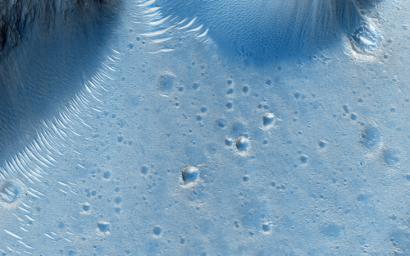
|
A Possible Alluvial Fan
- Click the image above for a larger view
- Full-Res JPEG (2880 x 1800) (869.0 kB)
- Full-Res TIFF (2880 x 1800) (15.6 MB)
Caption:

Map Projected Browse Image
Click on the image for larger version
This image shows the northern rim of a crater in Deuteronilus. At the northern end, we see the crater rim and ridges inside and below that rim. A channel set is entering from the west and passing through a notch in a ridge. Topographically below that notch, overlapping lobes spread over the crater floor .
Fan-shaped lobes likes these are also in the desert southwest of the United States, and are called "alluvial fans." They are caused when streams that carry sediment in a confined channel open up onto a plain or wide area, and deposit their sediment just outside of the channel mouth.
This is a stereo pair with ESP_028274_2160 .
Background Info:
The University of Arizona, Tucson, operates HiRISE, which was built by Ball Aerospace & Technologies Corp., Boulder, Colo. NASA's Jet Propulsion Laboratory, a division of the California Institute of Technology in Pasadena, manages the Mars Reconnaissance Orbiter Project for NASA's Science Mission Directorate, Washington.
Cataloging Keywords:
| Name | Value | Additional Values |
|---|---|---|
| Target | Mars | |
| System | ||
| Target Type | Planet | |
| Mission | Mars Reconnaissance Orbiter (MRO) | |
| Instrument Host | Mars Reconnaissance Orbiter | |
| Host Type | Orbiter | |
| Instrument | High Resolution Imaging Science Experiment (HiRISE) | |
| Detector | ||
| Extra Keywords | Color, Crater, Map | |
| Acquisition Date | ||
| Release Date | 2016-02-11 | |
| Date in Caption | ||
| Image Credit | NASA/JPL-Caltech/Univ. of Arizona | |
| Source | photojournal.jpl.nasa.gov/catalog/PIA20463 | |
| Identifier | PIA20463 | |
